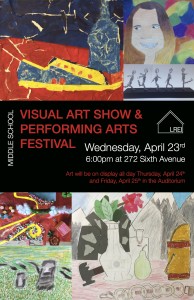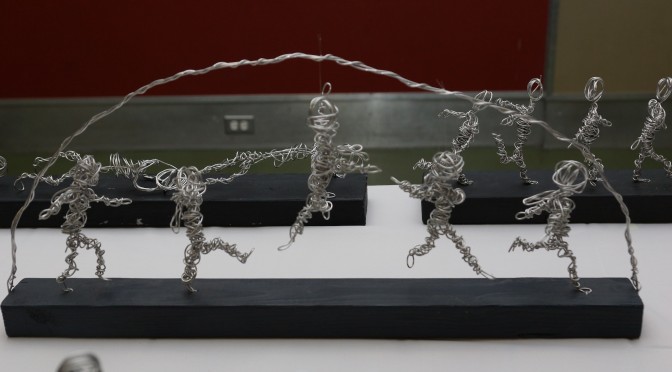 It was a pleasure to see so many of you at last night’s Middle School Art Show and Performing Arts Festival. For an evening that would suggest a focus on product and performance, I was struck by how much emphasis there was on highlighting the artist’s process. Visual art teachers Jeremiah Demster and Nathalie Hall and our young artists were engaged in regular conversations about the evolution of the work throughout the evening. At the same time, performing arts teachers Deborah Damast, Susan Glass, Joanne Magee, and Matt McLean and their students made sure that the evening’s performances were also balanced with insights into each groups working process as well.
It was a pleasure to see so many of you at last night’s Middle School Art Show and Performing Arts Festival. For an evening that would suggest a focus on product and performance, I was struck by how much emphasis there was on highlighting the artist’s process. Visual art teachers Jeremiah Demster and Nathalie Hall and our young artists were engaged in regular conversations about the evolution of the work throughout the evening. At the same time, performing arts teachers Deborah Damast, Susan Glass, Joanne Magee, and Matt McLean and their students made sure that the evening’s performances were also balanced with insights into each groups working process as well.
 With rehearsals for the Middle School Musical underway and the Spring Concert just around the corner, students participating in the full range of our performing arts programs have certainly been hard at work. The Art Show and Performing Arts Festival provide an opportunity for you to engage with your child about her/his journey as an artist this year. Through this dialog, we hope that you will be better able to appreciate the art as an embodiment of your child’s unique experience.
With rehearsals for the Middle School Musical underway and the Spring Concert just around the corner, students participating in the full range of our performing arts programs have certainly been hard at work. The Art Show and Performing Arts Festival provide an opportunity for you to engage with your child about her/his journey as an artist this year. Through this dialog, we hope that you will be better able to appreciate the art as an embodiment of your child’s unique experience.
As John Dewey comments in the opening of his seminal work Art as Experience:
In common conception, the work of art is often identified with the building, book, painting, or statue in its existence apart from human experience. Since the actual work of art is what the product does with and in experience, the result is not favorable to understanding. In addition, the very perfection of some of these products, the prestige they possess because of a long history of unquestioned admiration, creates conventions that get in the way of fresh insight. When an art product once attains classic status, it somehow becomes isolated from the human conditions under which it was brought into being and from the human consequences it engenders in actual life-experience.
When artistic objects are separated from both conditions of origin and operation in experience, a wall is built around them that renders almost opaque their general significance. Art is remitted to a separate realm, where it is cut off from that association with the materials and aims of every other form of human effort, undergoing, and achievement. A primary task is thus imposed upon one who undertakes to write upon the philosophy of the fine arts. This task is to restore continuity between the refined and intensified forms of experience that are works of art and the everyday events, doings, and sufferings that are universally recognized to constitute experience. Mountain peaks do not float unsupported; they do not even just rest upon the earth. They are the earth in one of its manifest operations. It is the business of those who are concerned with the theory of the earth, geographers and geologists, to make this fact evident in its various implications. The theorist who would deal philosophically with fine art has a like task to accomplish.
 What is it that Dewey wants us to understand? And how might this understanding inform our perspective on the role of the arts in progressive education in general and at LREI in particular? For us and for Dewey, the key notion is that the arts need to always be experienced as being alive in the present where they can provoke “fresh insight.”
What is it that Dewey wants us to understand? And how might this understanding inform our perspective on the role of the arts in progressive education in general and at LREI in particular? For us and for Dewey, the key notion is that the arts need to always be experienced as being alive in the present where they can provoke “fresh insight.”

 Even when works of art achieve something of the transcendent, Dewey does not want us to forget that they remain human endeavors that were born out of a particular need and created as a means to fulfill that need. In essence, the making of art represents an attempt to capture something vital about the human experience while existing as experience itself. So LREI visual and performing artists wrestle with a variety of materials and a variety of techniques in order to capture “an experience for a human being.” At the same time, that act of creation is also an essential part of the experience of being human.
Even when works of art achieve something of the transcendent, Dewey does not want us to forget that they remain human endeavors that were born out of a particular need and created as a means to fulfill that need. In essence, the making of art represents an attempt to capture something vital about the human experience while existing as experience itself. So LREI visual and performing artists wrestle with a variety of materials and a variety of techniques in order to capture “an experience for a human being.” At the same time, that act of creation is also an essential part of the experience of being human.



